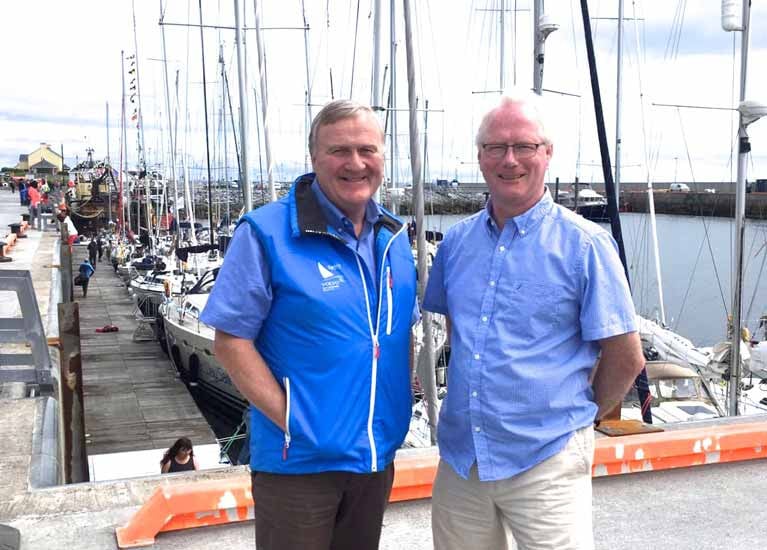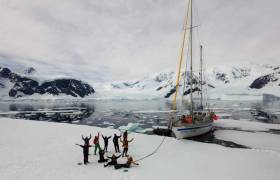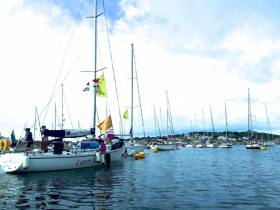Displaying items by tag: Cruising
Galway Family Sail the Dream to the Jungle & Paradise Islands
Last June, in what was meant to be the mid-summer period, Ireland was experiencing notably unseasonal weather with winds in the northerly sector which were cold - as anyone who took part in the biennial Dun Laoghaire Dingle Race will agree. Yet those cold winds were fair winds for anyone bound south down the Atlantic seaboard, and even as the racers to Dingle were settling into their post-race partying, an able-looking steel ketch came into port, crewed by a family who looked as though they’d appreciated the favourable passage-making conditions which had brought them and their dream ship down from Galway Bay at the start of a 14-month Atlantic circuit cruise.
Their dream ship is Danu, a rugged yet stylish Bruce Roberts-designed 13m Mauritius ketch, originally built in 1993 but brought up to superb condition by Vera Quinlan and her partner Peter Owens for this Atlantic project to provide a seagoing home (and schoolroom) for the couple and their two children, Lilian who was eleven when the voyage started from Kinvara last June, and nine-year-old Ruari.
 You don’t need extensive varnish work for a boat to look very well – the eminently practical Danu is a Bruce Roberts-designed 13m steel Mauritius Class ketch built in 1993. Photo: Vera Quinlan
You don’t need extensive varnish work for a boat to look very well – the eminently practical Danu is a Bruce Roberts-designed 13m steel Mauritius Class ketch built in 1993. Photo: Vera Quinlan
Vera Quinlan is “maritime royalty” – there’s no other way to put it. These days she’s a hydrographer on the INFOMAR project with the Marine Institute in Galway after years of international experience at sea and ashore completing research projects. And her sailing career well matches her professional life, for she’s a daughter of innovative architect Fergus Quinlan, who built his own 12m steel van de Stadt cutter Pylades, which he sailed round the world with his wife Kay in 2009-2012.
With this background, Vera was sailing her own Mirror dinghy by the age of 11, she then went on to Lasers, and by 16 she’d sailed on Asgard II during the visit to Australia in 1988, “an amazing and inspirational experience”.
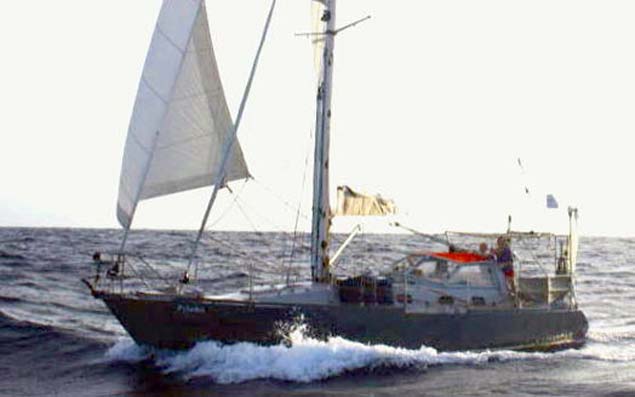 Fergus & Kay Quinlan’s Pylades, which he built himself and they sailed round the world in 2009-2012
Fergus & Kay Quinlan’s Pylades, which he built himself and they sailed round the world in 2009-2012 Vera Quinlan talking on marine research and the INFOMAR programme at an Irish Sailing Cruising Conference. Photo: W M Nixon
Vera Quinlan talking on marine research and the INFOMAR programme at an Irish Sailing Cruising Conference. Photo: W M Nixon
Cruising with her father when possible was another part of the seagoing mix, and when she linked up with adventurer and mountaineer Peter Owens, his lack of sailing experience was soon put right by getting her old Laser back into sailing trim, and putting him afloat to learn the basics. He needed to, for things seemed to be happening very quickly, as they got married and planned the honeymoon as a 15-month Atlantic circuit cruise fifteen years ago in the borrowed Pylades.
After that, they settled in the west of Ireland where the Clan Quinlan over three generations have made the southeast corner of Galway Bay their new ancestral home, and life has been decidedly busy and very maritime ever since. The international hydrography projects have played a key role in our growing understanding of the secret special world which surrounds our island, but with their new family of daughter Lilian and son Ruari taking to the waterborne life, Vera and Peter were determined that when the right time came, they’d have themselves organised with the right boat to take a 15-month sabbatical so that the four of them could enjoy the Atlantic circuit cruise together in that magic period when the children are old enough to fully experience the adventure, yet haven’t reached the age when they start having ideas of striking out on their own.
 Peter and Vera on Danu on the day of their departure from Galway Bay in June 2019. Photo: Pierce Purcell
Peter and Vera on Danu on the day of their departure from Galway Bay in June 2019. Photo: Pierce Purcell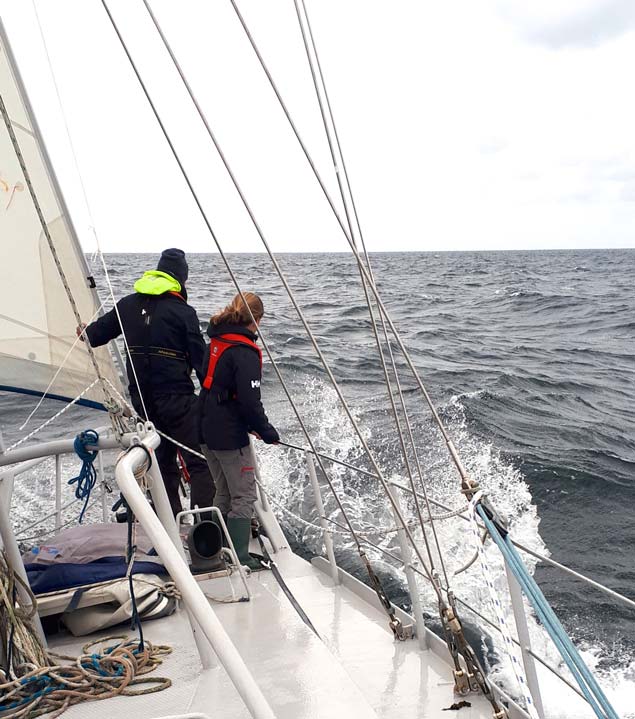 The winds for the first day of the voyage in Galway Bay may have been cold, but they were fair winds, and Danu’s crew were on dolphin watch before they’d got beyond the Aran Islands. Photo: Vera Quinlan
The winds for the first day of the voyage in Galway Bay may have been cold, but they were fair winds, and Danu’s crew were on dolphin watch before they’d got beyond the Aran Islands. Photo: Vera Quinlan
That said, when you’re as broadly and deeply involved in the maritime world as Vera Quinlan, describing an ocean cruise as “taking a sabbatical” doesn’t really get the flavour of it. She observes at it all with a special and professional viewpoint, and as reported in Afloat.ie on Thursday, the voyage of the Danu was used to locate an Argo research and recording float in mid-Atlantic between the Cape Verde Islands and French Guiana, an area which would normally be well beyond the scope of the Marine Institute in Galway.
Then too, Peter Owens has his own background in shoreside adventure and mountaineering, and the voyage has seen Danu being left securely berthed in some convenient harbour while the family venture inland to take on challenging mountain ranges such as the mysterious Picos de Europa in northern Spain, and the Atlas Mountains in North Africa.
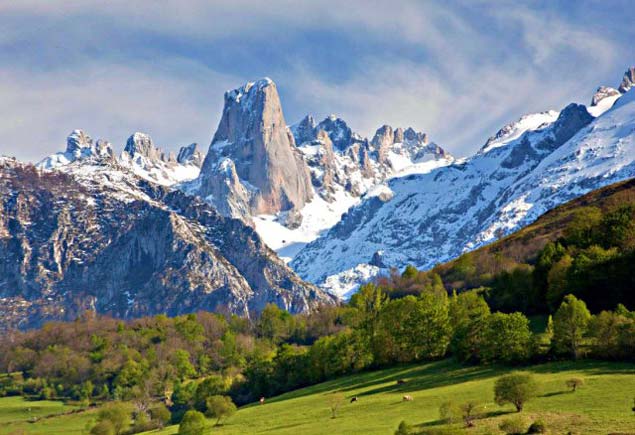 It wasn’t all “blue days at sea”. With Danu in a safe berth in Galicia, her crew went off to explore the mysterious Picos de Europa in Northern Spain
It wasn’t all “blue days at sea”. With Danu in a safe berth in Galicia, her crew went off to explore the mysterious Picos de Europa in Northern Spain
The entire hugely-varied experience is kept in context by relating it to the family’s home base in Kinvara, their links to the North Clare community around Bell Harbour, and with Galway Bay Sailing Club, which in 2020 is celebrating its Golden Jubilee.
Yes indeed, GBSC is fifty this year. And though reaching your 50th Anniversary may seem modest enough in a year when clubs in Ireland are celebrating Tricentenaries, Quarter Millenniums, Bicententaries, Sesquicentennials, 125th Anniversaries and whatever, getting a coastal sailing club going in Galway fifty years ago was a major achievement.
Then too, it’s doubtful if any of the more senior clubs have a member family undertaking an ocean cruise as complete as the Quinlan/Owen team during GBSC’s Golden Jubilee Year. So as Danu was leaving Vera promised that she’d send a Golden Jubilee Voyage Update by the end of January 2020, and thanks to that promise we can give this illuminating and practical insight into a true dream voyage.
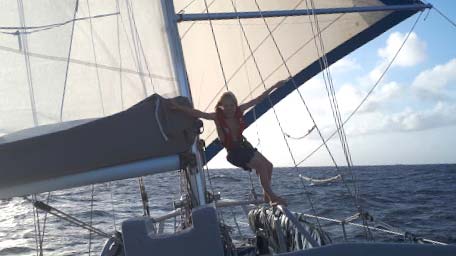 Lilian enjoying her first experience of Tradewind sailing. Photo: Vera Quinlan
Lilian enjoying her first experience of Tradewind sailing. Photo: Vera Quinlan
On 19th January Vera wrote:
“Danú and crew (Peter Owens, Vera Quinlan, Lilian (12) and Ruairí (10) all well, and enjoying the Caribbean islands. To date we have sailed 6500 nm from Kinvara south bound to the Isles of Scilly, Brittany, Galicia in northwest Spain, Portugal, Morocco, Madeira, Canaries, Cape Verde Islands and across the Atlantic to French Guiana.
With many miles under the keel to date, we have had plenty of sailing adventures. A few things stand out:
Entering into Rabat, Morocco under its ancient citadel, crossing the bar and negotiating ferries crossing the Bouregreg river. Then the harbour at Porto Santo, Madeira was an unexpected gem. We much enjoyed meeting Conor and Breda Minogue from Kinvara in Tenerife - they had chartered a yacht.
We experienced 30 knot plus winds and 4m seas from the Canaries to Cape Verde (Ed note: This region can see the Northeast Trade Winds in decidedly brisk mood – it was at the Canaries that Conor O’Brien with Saoirse recorded the best day’s run of his entire 1923-25 Round the World Voyage – it was 185 miles, and he reckoned they would have broken the 200 with an able alternative helm).
Vera resumes: We also happily recall the wonderful Bahia de Ferrios on Isla Brava of the Cape Verdes, where we filled with fresh water, and got ready for the Atlantic passage, preparing for the open ocean after some notable inland experiences, for we had left the boat in safe berths twice in order to explore the Picos de Europa in Northern Spain, and the Atlas in Morocco. The latter involved a challenging trek through semi-desert terrain of the Jebel Saghro region. We walked 150 km over the 6 days, sometimes in temperatures over 30 degrees.
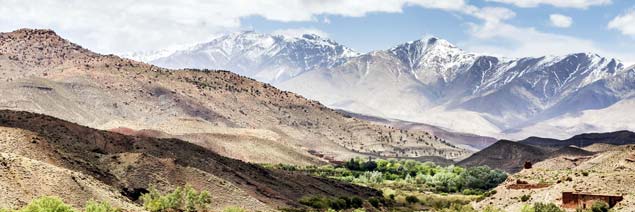 And now for something completely different…..the Atlas Mountains in Morocco involved Danu’s crew in a six-day trek
And now for something completely different…..the Atlas Mountains in Morocco involved Danu’s crew in a six-day trek
Thus the prospect of a real sea voyage was refreshing, but as it was the first proper ocean voyage for Lilian and Ruari, we’d planned the Atlantic crossing to be at one of the shortest hops, from the Cape Verdes across to French Guiana in South America.
For this passage across, we were joined by my cousin Chris Lacy, who had just completed his Yachtmaster qualification and wanted an Atlantic passage under his belt. We departed on the 29th November from Brava. The first few days we enjoyed great downwind sailing conditions, running with main and poled out genoa. We reefed and un-reefed as the conditions allowed, our average speed 6 knots, and daily runs of 145 nm.
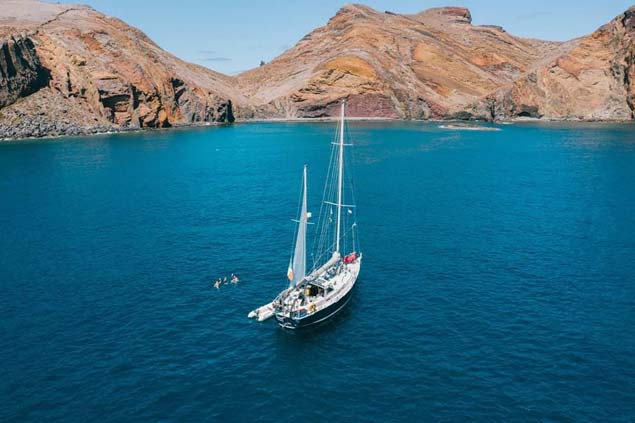 The Cape may be Verde, but some of the islands aren’t, yet Danu’s crew much enjoyed Bahia de Ferrios on Isla Brava before departing across the Atlantic. Photo: Vera Quinlan
The Cape may be Verde, but some of the islands aren’t, yet Danu’s crew much enjoyed Bahia de Ferrios on Isla Brava before departing across the Atlantic. Photo: Vera Quinlan By making their Atlantic crossing from the Cape Verdes to French Guiana on the South American mainland, Danu’s crew reduced the passage time to 13 days.
By making their Atlantic crossing from the Cape Verdes to French Guiana on the South American mainland, Danu’s crew reduced the passage time to 13 days.
For weather forecasting, we had planned on our satellite phone to download gribs from Predict wind. Unfortunately, we had a problem with the phone data cable and so we resorted to a voice call every two days to Fergus and Kay Quinlan beside Bell Harbour on the north coast of The Burren. They would note our position and current weather conditions and then send us a weather update by text. This worked very well, and it was wonderful through the miracle of modern technology to talk directly to someone in County Clare from the mid-Atlantic.
Four days into our crossing, we started to experience squalls with heavy rain showers, some of them torrential, allowing us to fill 5L water bottles from the coach-roof in minutes. Squalls would come in with ferocious intensity, and lightning was seen in the distance.
We ran dark with all electronics disconnected in case the electrical activity caught up us. It finally did on the morning of the 5th December, when a massive lightning bolt discharged a few meters from Danu's stern. We sailed on as quickly as possible, eventually getting somewhat clearer weather. We were informed from our Bell Harbour weather forecasters that the Inter Tropical Convergence Zone (ITCZ) had moved northwards, and as our Great Circle route was bringing us to 5 degrees North, we had no choice but to sail through it.
We enjoyed much brighter weather the following day, and we were able to deploy our Argo float. We had carried this instrument since leaving Ireland, a project we coordinated with the Marine Institute. This float will record temperature and salinity data from 2000m to surface level, on surfacing the instrument will download this data to the Marine Institute to aid climate change research. This Argo float will make this continuous 10-hour cycle for a period of 4 years.
Thanks to the Quinlan-Owens family from Galway for sharing this video of the deployment of a Marine Institute Argo Float in December.
— Marine Institute (@MarineInst) January 23, 2020
For more on this story please see - https://t.co/yWmgLbTLdD #marine #argofloat #ocean #data #research @EuroArgoERIC pic.twitter.com/5TXeTWZ9io
Despite pitching in the Atlantic swell we managed to deploy the float successfully, and our Mission Control Centre in the Burren relayed the message to the Argo team at the Marine Institute. A few days later we got the notification that the float was transmitting data successfully. Celebrations all around, as it is a first for Ireland to have an Argo float in this location.
Up to the 8th of December, we had the Trans-equatorial current with us, enabling good daily runs. On the 9th December, around 6deg40'N, 46deg22'W, we ran into a knot of countercurrent, and experienced swells from three different bearings. This made the sailing slow and uncomfortable – it’s amazing how seemingly small changes outboard can affect overall mood onboard…….
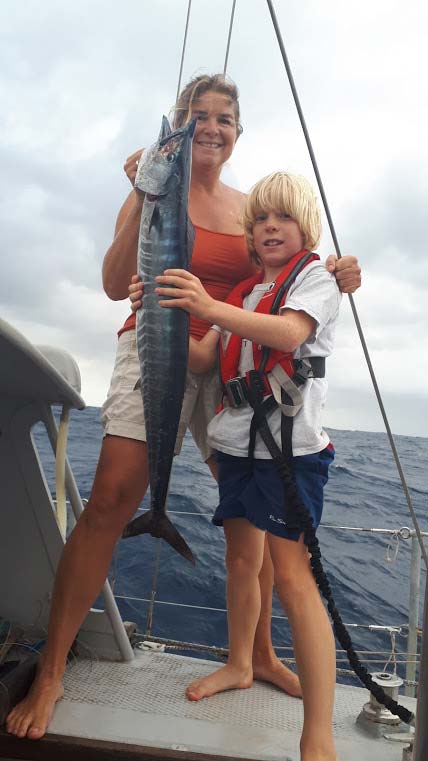 Something for immediate consumption and the larder. They don’t come fresher than a fish catch in mid-Atlantic. Photo: Chris Lacy
Something for immediate consumption and the larder. They don’t come fresher than a fish catch in mid-Atlantic. Photo: Chris Lacy
On the bright side, we caught some fantastic deep ocean fish such as dorade and wahoo which made delicious fresh eating, and provided huge excitement. Then by the 11th December after two days of adverse current, we started to pick up the favourable Guiana current, increasing as we sailed west. We made landfall at the Iles du Salut on the morning of the 12th December, making for a compact 13 day Atlantic passage.
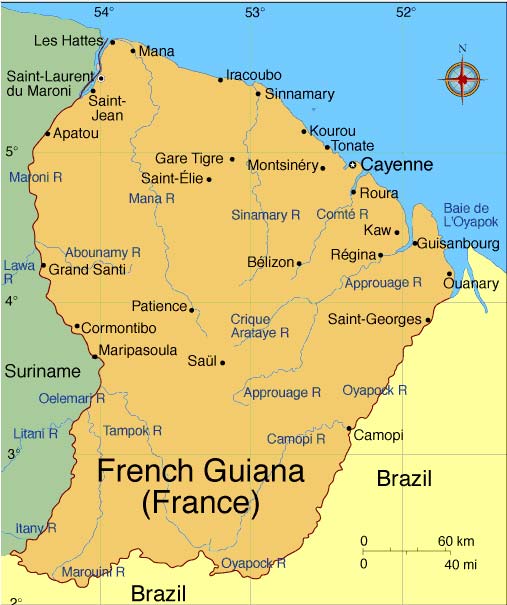 A very tropical place, French Guiana is slotted into South America between Brazil and the Dutch-linked Surinam.
A very tropical place, French Guiana is slotted into South America between Brazil and the Dutch-linked Surinam.
Notorious for being a former French penal colony centred around the infamous Devil’s Island in the north of the little group, the Salut Islands nowadays are a convenient stop before clearing into the French Guiana mainland. Relics of the old prisons remain, an eerie reminder of the times where France's most dangerous prisoners were sent, many never to leave the islands. They were made even more famous by the publication of the book 'Papillon', thrilling reading which acquired deeper meaning after seeing the place, particularly if you’ve sailed there - free as a bird - in your own boat.
After a few days exploring the islands, we left for the nearest mainland port at Kourou, marvelling at the shallow depths from there to the South American mainland. We spent three weeks in French Guiana, with one of the highlights being a Soyuz launch from the Space Center near Kourou - being so near the Equator, Kouro provides the minimum distance to Inner Space.
 Not something you’ll see on most cruises, yet Danu’s crew saw this happen at the Guiana Space Center in December.
Not something you’ll see on most cruises, yet Danu’s crew saw this happen at the Guiana Space Center in December.
In complete contrast to space travel, we navigated a narrow tributary of the Maroni River which marks the western boundary of French Guiana to anchor off an Amerindian settlement. Bringing Danú through a river where the trees of the rainforest almost touched the spreaders, yet with 10m depth beneath us, was incredible. We had Christmas dinner off the river port of St Laurent Du Maroni, managing to find a micro turkey in a local supermarket, while Santa read the GPS coordinates we sent and found us successfully……
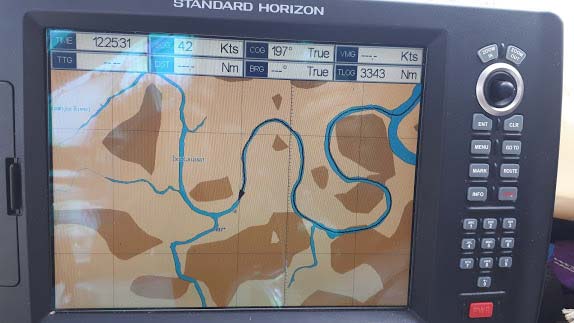 A very unusual place to spend Christmas, yet thanks to having the correct co-ordinates, Santa Claus managed to find Danu up this winding tropical river. Photo: Vera Quinlan
A very unusual place to spend Christmas, yet thanks to having the correct co-ordinates, Santa Claus managed to find Danu up this winding tropical river. Photo: Vera Quinlan How far can you get in place and mood from Kinvara in December? Danu in a tributary of the Maroni River in French Guiana. Photo: Vera Quinlan
How far can you get in place and mood from Kinvara in December? Danu in a tributary of the Maroni River in French Guiana. Photo: Vera Quinlan
French Guiana was definitely off the beaten track, with only a few boats of the 500 plus that crossed the Atlantic this season. We enjoyed going off the beaten track, but the almost constant rain, 100% humidity and mosquitoes were challenging, and we wondered how anyone would choose to live here. On Stephen's Day we departed for Bequia in the Caribbean, making the passage in 4 days.
Sailing on a fast reach in relatively calm sea conditions with 1.5 knots of Guyanian current was truly memorable. We sailed into Admiralty Bay, Bequia, marvelling at the crystal clear waters after so many days in the muddy cayman and piranha-filled rivers of French Guiana. Ruairi and Lilian were over-board and into the sea moments after we dropped anchor, and we welcomed friendly waves from many boats we had not seen since the Canaries.
We were elated to be here, having previously sailed into Bequia fifteen years previously on Pylades.
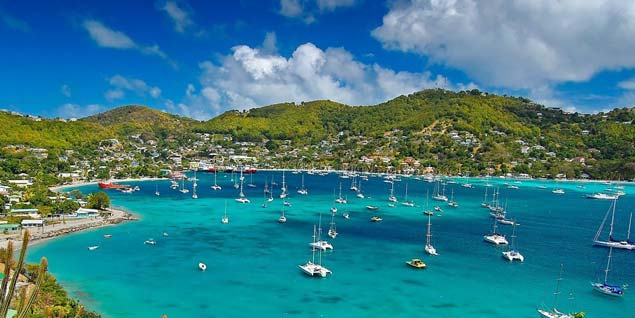 Bequia is in marked contrast to the muddy rivers and tropical rain of French Guiana
Bequia is in marked contrast to the muddy rivers and tropical rain of French Guiana
Now we are anchored in Chatham bay off Union Island. The weather has been uncharacteristically marked by high winds and rain showers so we have stayed here for four days, exploring Union by foot, the best being a hike through the forest to the highest point called 'da pinnacle'. On the way, you see tortoises, snakes, hummingbirds, hermit crabs and the unique Union Island gecko. The views from the summit are superb looking over to Clifton, the capital, with the islands of Petit Martinique and Petit St Vincent beyond. The reefs and special anchorages of the Tobago Cays are now beckoning, to which we depart in the morning. Meanwhile, warmest Golden Jubilee greetings to Galway Bay Sailing Club
Vera Quinlan
Peter Owens
Yacht Danú in the Caribbean
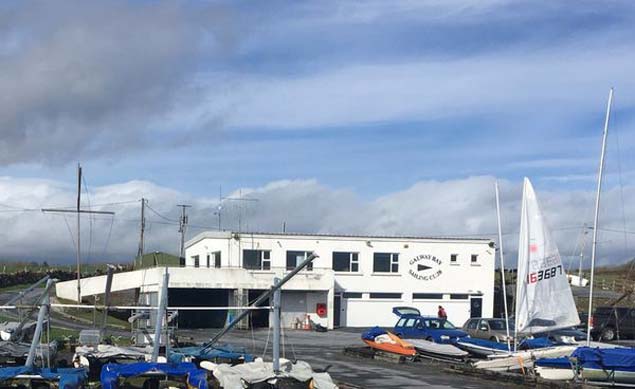 Home club. Galway Bay SC is celebrating its Golden Jubilee in 2020
Home club. Galway Bay SC is celebrating its Golden Jubilee in 2020
Cormac MacDonncha of Galway is December Sailor of the Month (Leadership in Sailing)
At year’s end, the Sailors of the Month adjudicators survey the overall scene in search of an outstanding and innovative event which has added to the variety of the Irish sailing programme. In 2019 this role was well filled by the Galway-Lorient Cruise-in-Company organised in July with great energy, enthusiasm and effectiveness by Cormac Mac Donncha. It attracted 27 boats including a French contingent, together with participants from as far north as Sligo on Ireland’s Atlantic seaboard, and set new levels of target achievement which similar future events will do well to match.
Exploration & Discovery at the 2020 Irish Sailing Cruising Conference
Exploration and Discovery is the theme for the 2020 Irish Sailing Cruising Conference at the National Yacht Club on 15th February 2020 at Dun Laoghaire Harbour in County Dublin.
Met Eireann Meteorologist and Wave Expert, Sarah Gallagher, will be talking about waves and how we can forecast them and the effects they have on our shores.
The highly respected ornithologist and Antarctic wildlife tour leader, Jim Wilson, will be sharing the story of the discovery of Antarctica by Irish man Edward Bransfield – yes a Cork man was the Leader of the first expedition to see and chart the Antarctic Mainland on 30th January 1820.
Damian Foxall, Niall MacAllister and Lucy Hunt, currently known as Team South, are leading a series of expeditions in Antarctica this winter and will be sending us a message from the ice and give a on the ground feel for life out there and what Bransfield would have seen.
There will be a ‘fireside chat’ with Jamie Young, Expedition Leader, Skipper and owner of Killary Adventure Centre, catching up on his trip to Greenland and the Arctic Circle and what he has learnt from his icy adventures.
Racing sailor and adventure cruising sailor, Christine Heath, will share her travels sailing her Sadler 28 to Holland, Sweden, Norway and Scotland these past few years. She is now nestled in Kilrush Marina and looking forward to exploring our wonderful west coast in 2020.
Vera Quinlan returns to the conference by video to share the latest developments on her family cruising adventure sailing round the Atlantic Circle.
Tony O’Leary of Union Chandlery gives some professional advice on anode types and galvanic corrosion and more environmentally friendly anode options.
Norman Keane has been busy sailing round Ireland with his drone and will present a birds-eye view of our ports and harbours.
Cruising Association of Ireland will give us an insight into their plans for 2020 cruising.
Royal Cork Yacht Club share their plans to celebrate Cork300 with the Wild Atlantic Way Cruising in Company.
Plus breakout workshops … details to follow nearer the date.
Union Chandlery is back on board as event sponsors for the 4 years running now and in true Union Chandlery style they will be giving away a bonus prize on the day and goodies for everyone.
Kilrush Marina and Cruising Association of Ireland are joining the event again as supporters. The support of these organisations helps to keep the entry fee down to cover bare costs and keep this fantastic event accessible to everyone.
The conference will also have limited spaces for marine industry companies and agencies to promote their goods in a small expo. If you are interested in exhibiting please contact Gail on [email protected].
Space is 100 seats, so early booking is recommended here
Strength in Numbers - Cruising Association Lifts the Liffey Bridges in Once-a-Year Display
John Leahy, Honorary Secretary Cruising Association of Ireland, reports on this year’s "Three Bridges Liffey Cruise"
The Cruising Association of Ireland’s “Three Bridges Liffey” cruise is an annual end of season mini social cruise which attracts a large number of East Coast sailors to mark the end of another summer afloat.
Typically hosting thirty plus yachts from 28 feet up to 50 feet, they cruise up the Liffey with dress flags fluttering as some skilled manoeuvring and helming is required to motor under and through three bridges, with it all followed by shared in-city berthing and an end of season dinner and much craic.
 Getting ready for the bridge transits – sometimes an extra fender is very helpful indeed. Photo: Aidan Couglan
Getting ready for the bridge transits – sometimes an extra fender is very helpful indeed. Photo: Aidan Couglan
The name “Three Bridges” comes from the fact that only once per annum, all three Liffey Bridges open simultaneously to permit the fleet to sail nearly up to the old limit point of Butt Bridge. A new pedestrian bridge is the last barrier these days, but they are within a couple of hundred metres of the centre of the city.
To get the three bridges open at once is a massive operation and thanks have to go to Dublin Port and Dublin City Council for permitting this to happen. Traffic management all over central Dublin has to be put in place, since during the cruise the only way over the eastern Liffey is the East Link and Butt Bridge.
This year the fleet was blessed with autumn sunshine on Saturday and 33 boats left the Poolbeg Sailing Club at 1230 hours to be there for the bridge opening at 1330. East Link opened first, followed by Samuel Beckett Bridge and then swinging pedestrian bridge upstream. They completed two circuits of the Liffey anticlockwise before berthing at the Liffey Port Pontoon beside the Point Arena - it was really quite a spectacle.
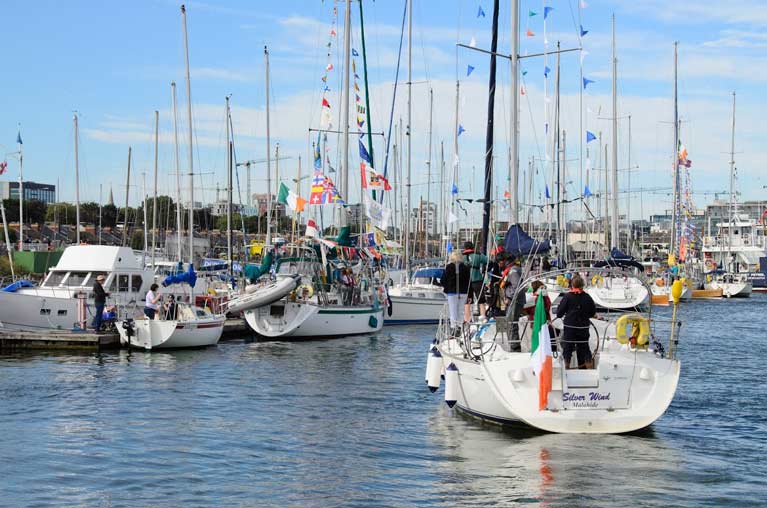 Warm weather, warm friendship – in conditions like this, there’s always room for more. Photo: Aidan Coughlan
Warm weather, warm friendship – in conditions like this, there’s always room for more. Photo: Aidan Coughlan
Many coastal cruises end with a stroll in a local village or social chats on deck, so this cruise organised a guided walking tour of Dublin led by Joe Varley for those looking for a stretch, while the rest of the gang enjoyed being rafted up in the warm sunshine and swapped stories of their summer cruises.
Cruising in company brings together the joy of sailing and exploring with the fun of socialising with like-minded sailors. CAI welcome new members at the very low rate of €30 per annum and not only provide a social and cruising calendar but great support and advice.
 The most-travelled – Pat Murphy’s Aldebaran from Howth is the veteran of a nine-year global circumnavigation. Photo:Aidan Coughlan
The most-travelled – Pat Murphy’s Aldebaran from Howth is the veteran of a nine-year global circumnavigation. Photo:Aidan Coughlan
The Ocean Cruising Club Challenge Grant Application is Now Open
The Ocean Cruising Club (OCC) has established a Challenge Grant to encourage ambitious cruising expeditions for environmental conservation or challenging oceangoing adventures and is now accepting applications for the 2020 season! The OCC Challenge Grant programme consists of two categories, the Conservation/ Environmental Grant and the Adventure Grant.
The Ocean Cruising Club membership has had a long tradition of adventurous ocean sailing and marine conservation activities. Whether high latitudes voyaging, non-stop solo circumnavigating, sampling ocean waters, or researching threatened species, OCC members’ adventures and conservation efforts, documented in its flagship publication The Flying Fish, have helped sailors dream big and plan exciting and meaningful voyages.
Now, with decades of storied history, the OCC continues to support these endeavours and is proud to stand behind the individuals and their projects which seek the betterment of the sailing community and maritime environment. Champion of the concept, Commodore Simon Currin, was encouraged by the endorsement of the Board, Committee and members. “I believe that these Grants, when combined with the OCC support that comes with them, will be a potent stimulus to teams and individuals planning exciting projects and adventures for 2020 and beyond. I am delighted that the OCC has chosen to become a patron of conservation and adventure worldwide.”
The OCC Challenge Grant encompasses two categories: the Conservation or Environmental Grant and the Adventure Grant. Grants are intended to help with project costs and range from £250 to £3,000, depending on the size and scope of the project.
Project lead, Baxter Gillespie notes, “The applications will be reviewed and judged by members of OCC who have experience in planning and executing major expeditions and projects such as high latitude firsts, mid-ocean scientific research, and remote island refuse reclamation. Their assessment of candidates’ goals and qualifications will be based in an extraordinary depth of expertise. I encourage candidates to apply as early as possible to secure consideration as we have a limited number of grants each year.”
The OCC Challenge Grant – Conservation
The OCC’s Conservation grant is for members looking to make a difference with a specific conservation or environmental project that is centred around the ocean, marine or maritime environment.
Conservation projects should:
· Be related to the ocean, maritime or marine environments
· Have measurable, high impact yet achievable goals
· Incorporate best practices for sustainability
· Improve the marine conservation and/or conservation practices
· Demonstrate “Leave No Trace” practices
· Demonstrate a plan for long-term success
· If possible, engage members of the community to ensure the sustainability of the project
· If possible, have local and national conservation manager endorsement and appropriate local/national licensing where necessary.
· Have a realistic budget
· Incorporate the best ethical practices
The OCC Challenge Grant – Adventure
This Grant is for sailors in pursuit of world-class sailing and sail exploration objectives. Adventure Grants are intended to more significantly contribute towards total expedition costs.
Adventure Grant Goals:
The Adventure Grant seeks to fund individuals planning expeditions to remote areas, featuring unexplored areas, difficult sailing routes, challenging multi-sport exploits, or similar world-class pursuits.
For details on how to apply, please visit the OCC Challenge Grant page on the website.
Galway Cruise Flotilla Arrive at Lorient Harbour
Irish flags are flying during last Saturday's final short hop across in Galway Sailing's Cruise to Lorient.
The photo taken from the citadel at the entrance to Lorient Harbour shows some of the 25-boat flotilla from the west of Ireland on the Galway - Lorient twinning cruise before being hosted by the Deputy Mayor at City Hall.
The leading boats pictured were Trilogy, skippered by Jeangab Zamsun of Lorient and Lean Machine, skippered by Cormac Mac Donncha of Galway.
Read the full account of the Galway Lorient twinning cruise by WM Nixon here.
Even the most experienced amateur sailors will always feel a certain nervousness mingling with the anticipation in starting a cruise writes W M Nixon. This is particularly so when the cruise will take them out of sight of land, and through nights at sea. Yet it brings its rewards, and today an impressive and varied fleet of 27 cruising boats, mostly from Ireland’s western seaboard, will be gathering in Lorient in Brittany after a 553-mile cruise-in-company along exposed coasts and across open ocean from Galway Bay, a joint venture which got underway a week ago.
For many “Nervous Novices”, the notion of broadening one’s seagoing experience through mutually-supportive Cruises-in-Company has an obvious appeal. This concept has been central to the thinking of some noted movers and shakers in Galway Bay Sailing Club and along the west coast. They’ve become increasingly keen in recent years to re-invigorate the maritime links which focused on the connections between Galway and Lorient, the main port in southern Brittany, which is best known to non-sailors as the host town of the annual Inter-Celtic Festival, whose visitors have included President Michael D Higgins.
 The basic track chart allows room for diversions in the home waters of the Celtic Fringe, along what most sailors from elsewhere would see as distinctly rugged coastlines
The basic track chart allows room for diversions in the home waters of the Celtic Fringe, along what most sailors from elsewhere would see as distinctly rugged coastlines
 To date, the Cruise-in-Company has enjoyed mostly gentle weather, including perfect sunrises and sunsets which emphasise the special nature of the coastlines they’re visiting
To date, the Cruise-in-Company has enjoyed mostly gentle weather, including perfect sunrises and sunsets which emphasise the special nature of the coastlines they’re visiting
The sailing links were particularly active during the 1970 and ’80s, with regular inter-changes of boats and people, while the existence of a now re-focused Glenans Ireland base in Clew Bay played its role. But since then, the visible lines of sailing communication between Ireland and Brittany have tended to take on a more professional flavour, with major events setting the pace, such as the Volvo Ocean Race, the Figaro, and the fact that French boats have registered so much success in the Round Ireland and Fastnet Races.
Yet the memories of those more informal amateur contacts, based on genuine friendship across the sea and along the Celtic coasts between two formally-linked Atlantic ports, have never faded. And while Galway sailing’s busy folk such as the always-innovating Cormac Mac Donncha have seen much of their energy taken up with events such as the first staging of the WIORA Championship in the Aran Islands - it happened with great success in 2017 with a remarkable 44 boats taking part - the seeds of the idea of a new Galway-to-Brittany Cruise-in-Company, planted by Galway’s Enda O Coineen, were beginning to take root.
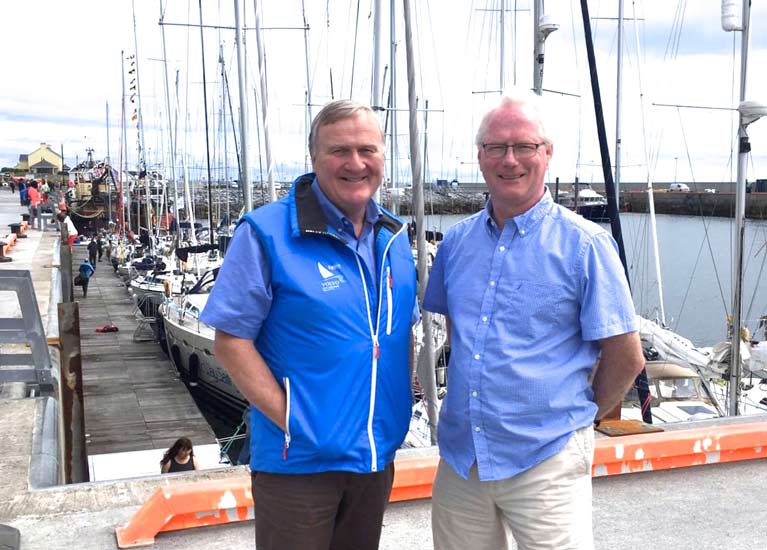 Irish Sailing President Jack Roy (left) with GBSC’s Cormac Mac Donncha at the WIORA Championship in the Aran Islands, July 2017
Irish Sailing President Jack Roy (left) with GBSC’s Cormac Mac Donncha at the WIORA Championship in the Aran Islands, July 2017
Cormac Mac Donncha soon found fellow-enthusiasts among GBSC clubmates such as John Killeen, Pierce Purcell and Johnny Shorten and others. Then, too, the international connections of Enda O’Coineen – particularly along the coast of France following his Vendee Globe involvement and Figaro support programmes – have proven invaluable in ensuring that if they managed to get a fleet together, there would be proper reception arrangements in place at each port to make them welcome and cater for their needs.
The links across the sea were also developed at more official levels building on the connections between the Mayor of Galway Mike Cubbord and his counterpart in the twinned arrangement with Lorient which has been in place since 1975, with Catherine Gagneux of the French Consulate in Galway much involved, and back on water the active support of Jean-Gab Samzun, President of Lorient YC and a frequent visitor to Cork Week, was also readily forthcoming and his 46ft S&S-designed former Admirals Cupper Trilogy is one of the three French boats which came to Galway to join in the venture.
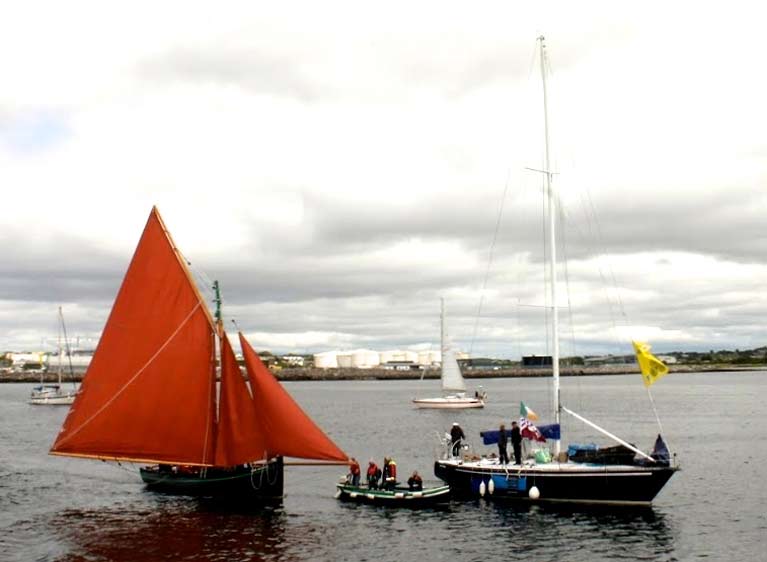 Lorient YC President Jean-Gab Samzun’s former Admiral's Cupper, the S&S 46 Trilogy (right), with Peter Connolly’s Galway Hooker from The Claddagh, which sailed out to the start off Galway to wish the fleet bon voyage. Photo: Patricia Cannon
Lorient YC President Jean-Gab Samzun’s former Admiral's Cupper, the S&S 46 Trilogy (right), with Peter Connolly’s Galway Hooker from The Claddagh, which sailed out to the start off Galway to wish the fleet bon voyage. Photo: Patricia Cannon
As the possible structures were being explored, research among potential participants was also underway for an event which was now set to come together with the Official Departure from Galway city on Friday, July 12th. In the greater Galway Bay area, Pierce Purcell had for some years been developing a list of all boats and boat-owners, a valuable database whose maintenance has now been taken over by GBSC’s Johnny Shorten. That provided a rewarding source of potential participants, but then it was found that others could soon be found beyond boats based within the limits set by Slyne Head, the Aran Islands, and Black Head.
In fact, potential cruisers-in-company were found all along the West Coast – the Wild Atlantic Way – and even round on to the south coast and Cork Harbour, while it extended inland with three entrants from Mountshannon and Garrykennedy on Lough Derg.
It’s the “hidden boats” of the westerns seaboard which provide the unexpected ingredient. For instance, anyone who is unfamiliar with the place, and arrives for the first time at Rosmoney, the base of Mayo Sailing Club hidden among the islands at the head of Clew Bay, will be pleasantly surprised by the size and quality of the cruiser fleet there. But then, Rosmoney is only “remote” for someone who lives outside Mayo. The thriving county town of Castlebar supports a significant boat-minded community, and so do many other places along the west and southwest coasts.
So although it’s quite a logistical challenge to commit yourself and your crewing recruits to an event which will involve sailing an absolute minimum of 1,106 mostly offshore miles by the time you’ve returned to Galway Bay, boats from as far north as Sligo signed up, as did one boat from Cork in the opposite direction. Indeed, such was the enthusiastic regional response that boats from Galway Bay SC itself, while still the largest club entry, have ended up in a minority of the fleet.
 The most northerly-based participant, Dave O’Connor’s Reflex 38 Lynx from Sligo, in Galway Harbour before the start. Photo: Patricia Cannon
The most northerly-based participant, Dave O’Connor’s Reflex 38 Lynx from Sligo, in Galway Harbour before the start. Photo: Patricia Cannon
The entry list is intriguing, particularly when taken geographically north to south:
SLIGO YACHT CLUB
Lynx (Reflex 38): Dave O'Connor, Nigel Moss, Adam Sutor, Ian Tobin, Dennis Kashyn, Brian Moloney, Barry Shockly, Paddy Cassidy.
MAYO SAILING CLUB
Freebird (Achillles 9 Metre): Duncan Sclare, Maura Bourke Charles Scott.
Blue Moon: John Lambe
Carp Diem (Delphia 37): Brian Quinn, Sheila Molloy, Colin Wolfe
Coco (Jeanneau 42) J. McAllister
CLIFDEN SAILING CLUB
Moon River (Dufour 30): Rev. Anthony Previte
GALWAY CITY SAILING CLUB
Roamer (Contessa 32): Frankie Leonard, Frank Leonard Snr, Andraus Bauman, Fergal Diviney, Rob Talbot, Rian de
Bairead
Euphanzel III (Shipman 28): Gerry Moran
GALWAY BAY SAILING CLUB
Lean Machine (J/35): Cormac MacDonnacha. Dan King, Cathal Byrne, Eugene Osborne, Niamh Tyrell, Ken MacNamara
Imperator (Gladiateur 33): Tony Collins, John Shorten, Justin Shorten, Aonghus Concheanainn
Inis Bearachain (Sirius 38): Patrick & Connie Ryan, John Preisler, Eugene Burke
Feeling Groovy (Elite 36): Alan Lane, TJ Corcoran, Hugh Loftus, Con Brosnan
Rhocodar (Dehler 39): Tomas Furey, Aine Nolan, Lorraine Scully, Caroline Higgins, Tricia MacNamara. Grace Denny. Alan Donnelly
Stars are Out: Colm Moriarty
Yapper: Walter McInerney
INISCEALTRA SC
Seesaw: J Farrell
GARRYKENNEDY SC
Lisador (Dehler 36): Henry Hogg, Andy Flanagan, Sean Collins, Dan O'Donnell
Ocean Tango: Ollie Kierse . Steve Lynch
ROYAL WESTERN OF IRELAND YACHT CLUB
Sheenaun (Southerly 47): Louis Keating, Maeve Howard . Kathleen Nolan, Fergus Daly
Amergin: Pat O'Shea, Ruth O'Shea, Jim Lawlor.
ROYAL CORK YACHT CLUB
Split Point (Dufour 34): Seamus Gilroy
LORIENT YACHT CLUB
Trilogy III (S&S 46): Jean-Gab Samzun
Sunfast 36: (Guillermic)
Hallberg Rassy 42: (Bouyer)
Passade.
The project acquired a more thoughtful aspect after the French lifeboat accident in Storm Miguel in the Bay of Biscay on June 7th saw the loss of three lifeboatmen’s lives, and as already reported in Afloat.ie the Cruise-in-Company will carry messages of goodwill and condolences for the French rescue services from Galway Harbour Master Captain Brian Sheridan and the Galway RNLI.
As the start date approached, the pace became hectic with the three French boats arriving in from Brittany and those from north of Galway Bay (it’s 91 nm from Rosmoney) making their way south. It all started to become official on Thursday evening (July 11th) with a “Grand Fete de Departure” for all crew and their shoreside supporters – formal and otherwise – at the Harbour Hotel, with a perpetual trophy being presented by Phyllis Molloy, widow of the late Government Minister and former GBSC Commodore Bobby Molloy TD, to Gerry Moran, skipper of the smallest entrant, the Shipman 28 Euphanzel III, a boat type which Bobby Molly himself sailed back in the 1970s when links with Lorient were getting into their stride.
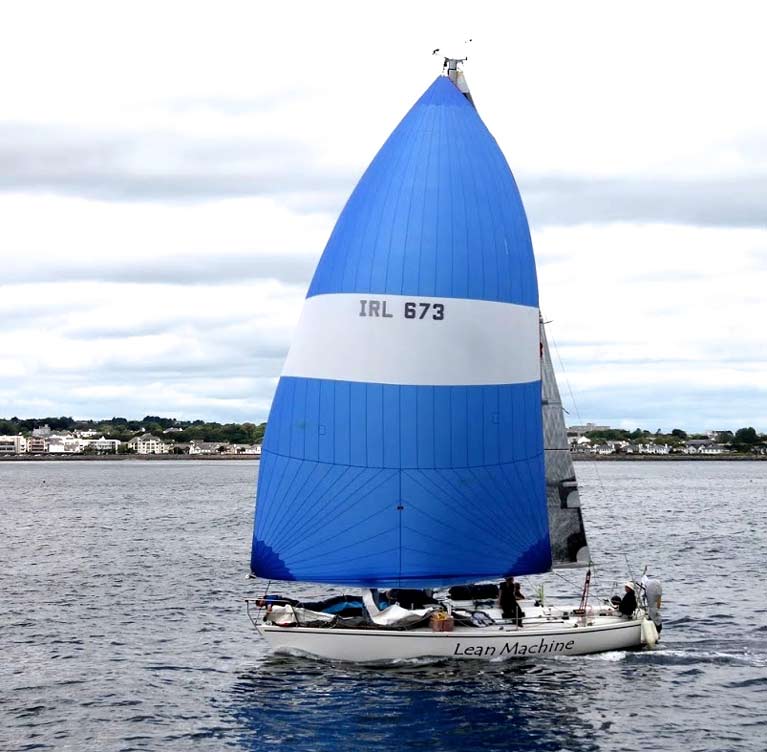 It may have been a Cruise-in-Company, but the J/35 Lean Machine (Cormac Mac Donncha) departed Galway in full racing mode. Photo: Patricia Cannon
It may have been a Cruise-in-Company, but the J/35 Lean Machine (Cormac Mac Donncha) departed Galway in full racing mode. Photo: Patricia Cannon
The send-off next evening was pure Galway, with traditional boat sailor Peter Connolly of the Claddagh coming out to the fleet to distribute goody-bags of turf and poitin for gifts to Brittany, and the departure was also saluted by Kinvara’s Cruinnui na mBad organizer Mick Brigan (the 40h Anniversary is August 9th to 11th 2019) with his king-size ketch-rigged Galway Hooker Mac Duiach, on his way to Roundstone to be in place for the Mac Dara’s Day traditional racing on Tuesday.
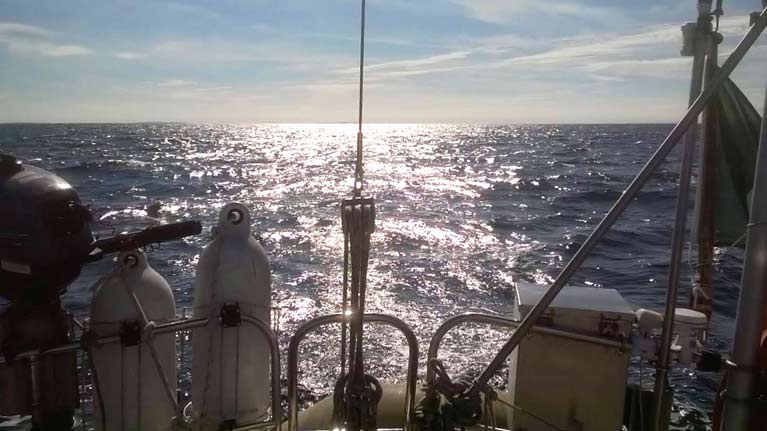 It was a good time to be heading south, with foul weather to the north of Ireland, yet conditions were like this for the Galway-Lorient Cruisers-in-Company in the Celtic Sea. Photo: Patricia Cannon
It was a good time to be heading south, with foul weather to the north of Ireland, yet conditions were like this for the Galway-Lorient Cruisers-in-Company in the Celtic Sea. Photo: Patricia Cannon
Conditions were gentle for progress around the southwest coast and the first stopover after making good 219 miles was at Kinsale, where the welcome was warm and the fleet achieved full size. Then it was away at dawn on Tuesday for a mostly light wind passage to Hughtown on St Mary’s in the Isles of Scilly (131 nm) where the fleet were in place by Wednesday morning as a weather frontal system went through to ensure that they’d have fair winds for the next stages.
By this time there were so many Galway boats in Hughtown that the Harbour Master Dale Clark wondered if any were left at home at all, and in honour of their presence he flew the GBSC burgee from the flagstaff on his launch, while before they left the Galwaymen gave him a special token of their thanks. But as ever the next port was calling, in fact some boats had availed of the good conditions to go on across the mouth of the English Channel to the very special island of Ushant where at least three boats – with Roamer and Feeling Groovy among them – had themselves a fine old time with GBSC Rear Commodore Johnny Shorten providing official approval.
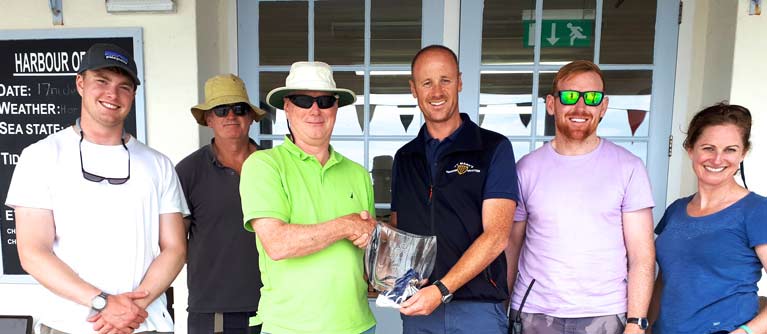 Cormac Mac Donncha, Fleet Organiser GBSC, making a thank-you presentation to Hughtown Harbour Master Dale Clark on Wednesday – left to right Cathal Byrne, Eugene Osborne, Cormac Mac Donncha, Dale Clark, Dan King and Niamh Tyrrell
Cormac Mac Donncha, Fleet Organiser GBSC, making a thank-you presentation to Hughtown Harbour Master Dale Clark on Wednesday – left to right Cathal Byrne, Eugene Osborne, Cormac Mac Donncha, Dale Clark, Dan King and Niamh Tyrrell
Back in Hughtown meanwhile, organizer Cormac Mac Donncha with his J/35 Lean Machine found himself in the Good Shepherd role. It was 2300hrs on Wednesday evening before he was certain that all his flock were well on their way southwards or otherwise safely accounted for, and then he took his farewell of the friendly Isles of Scilly and Lean Machine went to sea as the tail-ender in the procession to South Brittany.
According to the programme, the next stop was to be Ile de Groix, though some thought they’d see the full hop to Lorient put astern before really relaxing. Whatever, the weather during the past couple of days has been generally better south of Ushant and winds have been providing a beam reach, so even if there’s been the occasional spot of rain, the underlying trend has been in the right direction for the time being.
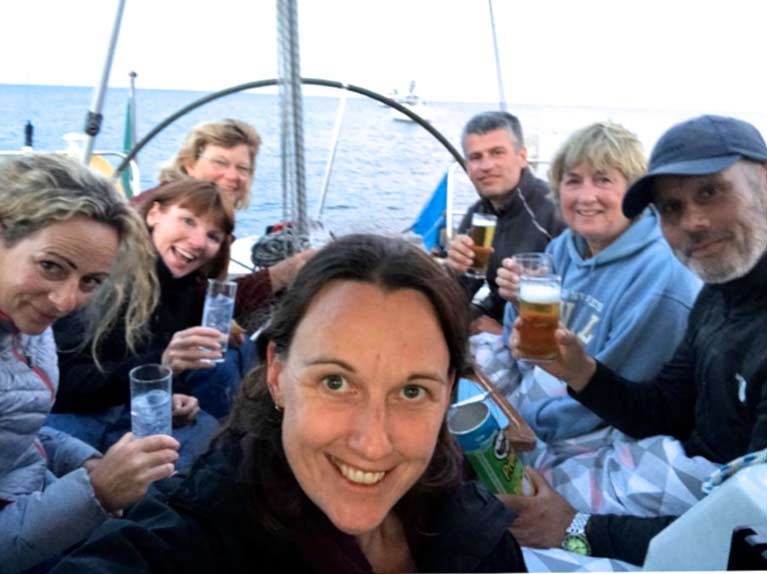 We’re here! The crew of Rhocodar in celebratory mood in the open anchorage at Ushant are (left to right) Tricia MacNamara, Grace Denny, Aine Nolan, Lorraine Scully, Tomas Furey, Caroline Higgins and Alan Donnelly. Photo: Lorraine Scully
We’re here! The crew of Rhocodar in celebratory mood in the open anchorage at Ushant are (left to right) Tricia MacNamara, Grace Denny, Aine Nolan, Lorraine Scully, Tomas Furey, Caroline Higgins and Alan Donnelly. Photo: Lorraine Scully
In any case, with even the relative beginners finding more confidence with every mile sailed, trying to keep to a close schedule and itinerary becomes increasingly difficult. In fact, it’s like herding cats, so space had been left in the programme for diversions such as that made to Ushant, which Tomas Furey’s Dehler 39 Rhocodar crew much enjoyed, and they then went on to Concarneau with Frankie Leonard’s Contessa 32 Roamer, where an entertaining contact was made with the one and only Tom Dolan.
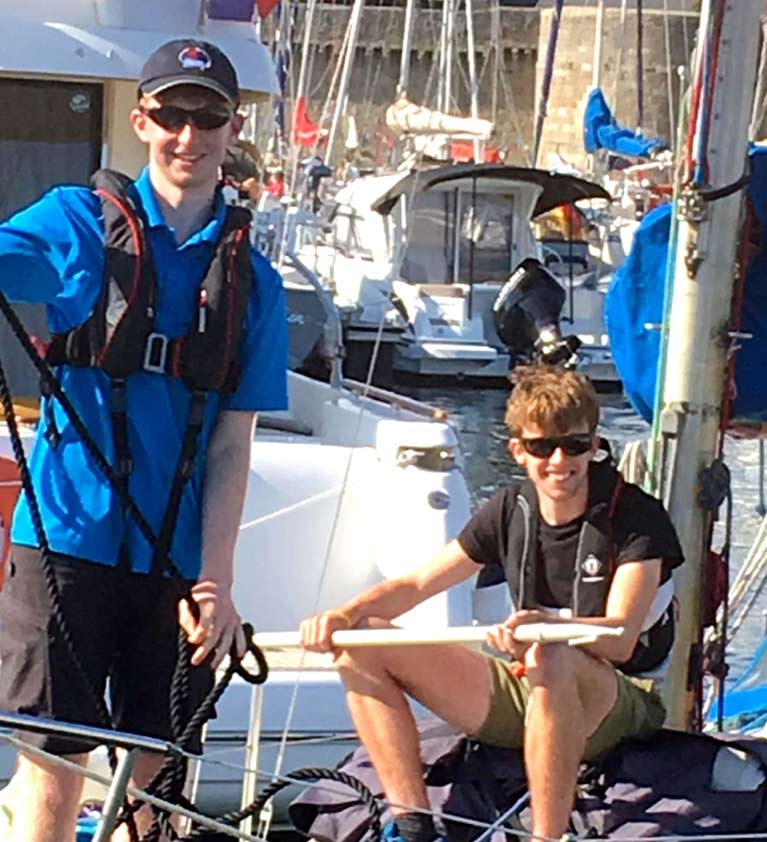 Young voyagers. Rian de Baraid and Rob Talbot on Frankie Leonard’s Contessa 32 Roamer (Galway City SC) after reaching Concarneau. Photo: Lorraine Scully
Young voyagers. Rian de Baraid and Rob Talbot on Frankie Leonard’s Contessa 32 Roamer (Galway City SC) after reaching Concarneau. Photo: Lorraine Scully
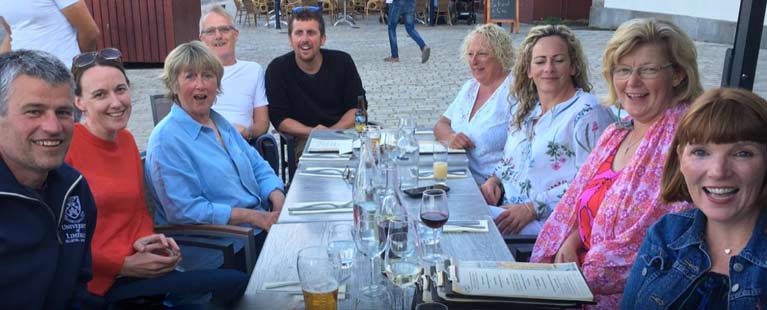 Local hero. Tom Dolan with the crew of Rhocodar at Concarneau. Photo: Lorraine Scully
Local hero. Tom Dolan with the crew of Rhocodar at Concarneau. Photo: Lorraine Scully
Today, all being well, those still in the fleet will be assembling at Port Tudy in the Ile de Groix, and then they’ll set off in formation at 4 pm to arrive in Lorient at 6 pm, where they’ll find much of interest including the Galway Inn where the word is they’re ready and waiting. And as their fleet berth is in Kermevan where the legendary U-Boat Pens are reminders of another aspect of Lorient’s history (think of the superb war movie Das Boot), they’ll find much to compare with home.
For the reality is that when Galway was already a tough, compact and very complete little walled city punching way above its weight, what is now Lorient was only a sparsely populated collection of cottages considered of little significance. Things have changed more than somewhat since then.
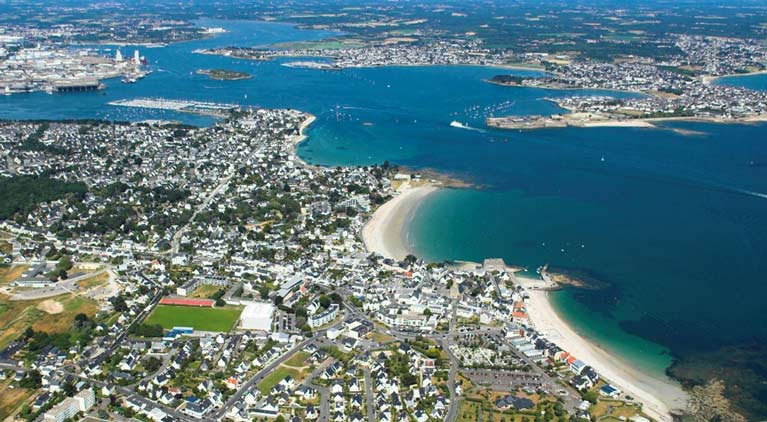 Lorient today – a place of multiple facilities and considerable significance
Lorient today – a place of multiple facilities and considerable significance
 Ready to make their arrival – part of the Galway fleet in the Ile de Groix this morning, flags flying for the final short hop across to their Lorient reception this evening. Photo: Lorraine Scully
Ready to make their arrival – part of the Galway fleet in the Ile de Groix this morning, flags flying for the final short hop across to their Lorient reception this evening. Photo: Lorraine Scully
Three French lifeboat crew who died in a recent sea rescue will be remembered by a fleet of west of Ireland sailing craft setting sail from Galway for the Breton port of Lorient later this week writes Lorna Siggins.
Bearing sods of turf, the “cruise in company” involves some 30 yachts and classic craft, including the Galway Hooker MacDuach.
As Afloat previously reported in May, French honorary consul Catherine Gagneux will be in Lorient to greet the fleet, leaving Galway on Friday (July 12) and expected on or about July 20th/21st, weather permitting.
The fleet from Mayo, Galway, Clare, Cork and further afield will fly “battle flags”. Celebrations are planned to mark almost 45 years of a twinning between Galway and Lorient.
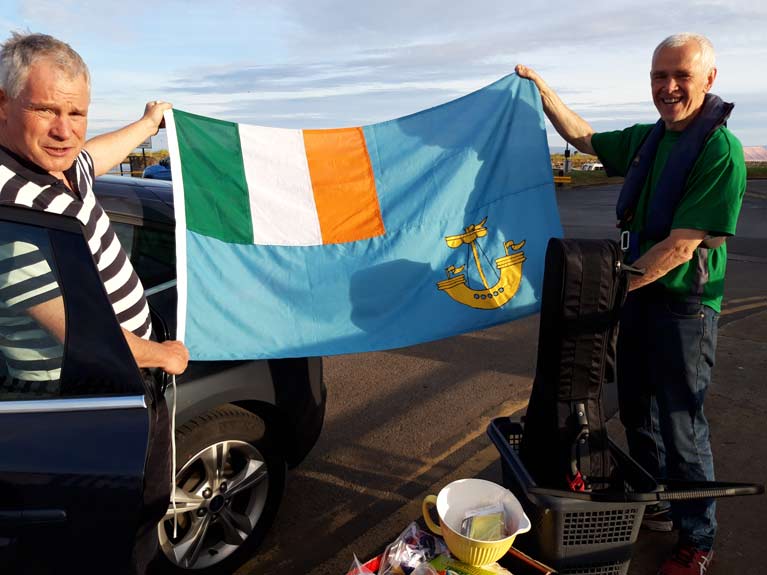 Johnny Shorten and Tony Collins (left to right) of Galway Bay Sailing Club Photo: Catherine Gagneux
Johnny Shorten and Tony Collins (left to right) of Galway Bay Sailing Club Photo: Catherine Gagneux
Ms Gagneux says the voyage is particularly significant, as one of the craft will sail with a signed flag from Galway rescue volunteers to honour three French lifeboat crew who died recently in Sables d’Olonne, some 100 km north of La Rochelle.
A letter of condolences from Galway harbourmaster Capt Brian Sheridan will also be presented to the Groix Island Sea Rescue, near Lorient.
The French crew members were part of the rescue organisation, Société Nationale de Sauvetage en Mer which went to the aid of a fishing vessel during Storm Miguel on June 7th.
The lifeboat capsized due to severe weather conditions, which saw winds of up to 120 km per hour. Four of the seven crew were able to swim ashore.
The Galway-Lorient cruise was initiated by Enda O Coineen, along with Cormac Mac Donncha from ThermoKing in Galway, and Jean-Gab Samzun, the president of the Lorient Galway association - also known as a real 'Vieux Loups de Mer' (Old Sea Dogs ), Ms Gagneux explains.
Sailing fleets from both Galway and Lorient had participated in a number of events in the 1970s, and 1980s and the aim of the “Great Celtic Cruise Adventure” is to revive this tradition.
The 1100 nautical mile return voyage - 550 nautical miles each way - will have three stopovers in Kinsale, Co Cork, for Bastille Day on July 14th; the Scilly Isles; and Ile de Groix.
Mr MacDonncha says that the bags of turf were requested by “Celtic cousins” in Brittany to commemorate the role of working boats such as the Galway hookers who delivered such cargo to the Aran Islands and along the west coast before electricity and diesel were used to heat homes.
Mr Samzun will lead the fleet, along with Galway Bay Sailing Club vice-commodore and voyage organiser Johnny Shorten.
Ms Gagneux says that further social, economic and cultural projects will mark 45 years of the Galway-Lorient relationship in September 2020.
Midsummer’s Weekend, and Irish sailing pauses for breath in this most hectic of sailing seasons writes W M Nixon. There are other events going on during these next two days, but let’s hope the most relaxed and non-competitive tone is set up in Portaferry in the entrance to Strangford Lough at the annual three day Sails and Sounds Festival.
Admittedly with Portaferry SC at the heart of things, there is some competitive racing in the lough itself today (Saturday), with the emphasis on traditional craft. But with the likes of the vintage schooner Soteria setting the pace, it’s character rather than speed which will be the priority.
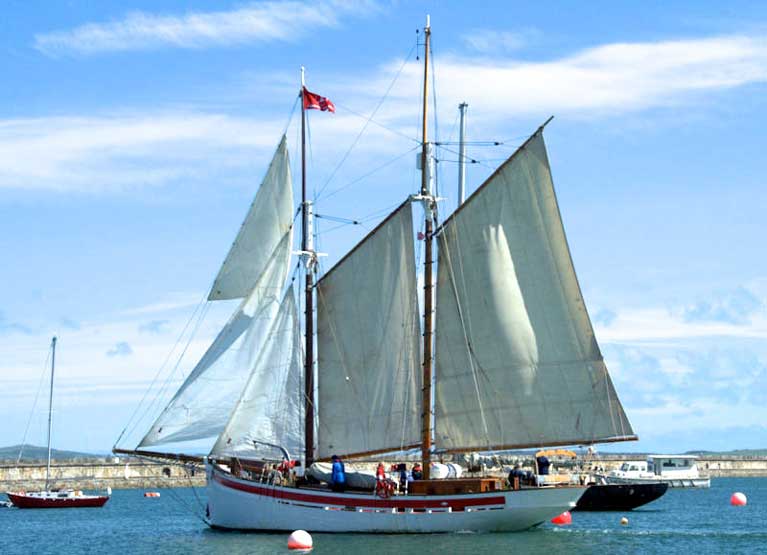 A ship of character. The 1932-built traditional schooner Soteria will be playing a central role in this week’s Portaferry Sails & Sounds festival in Strangford Lough
A ship of character. The 1932-built traditional schooner Soteria will be playing a central role in this week’s Portaferry Sails & Sounds festival in Strangford Lough
Meanwhile, for those with a larger vision of what the sailing life can offer for those who have the energy, vision and organisational capacity to grasp some of its many opportunities, this week’s focal point has been the early days of the 14-month family cruise on the Atlantic circuit being under undertaken by a noted Galway cruising family with their 43ft ketch Danu.
For those of us who have heard Vera Quinlan of the Marine Institute speak at an Irish Sailing Cruising Conference, there’s an informed awareness that here is someone who is in the forefront of the projects to realise Ireland's boundless maritime potential.
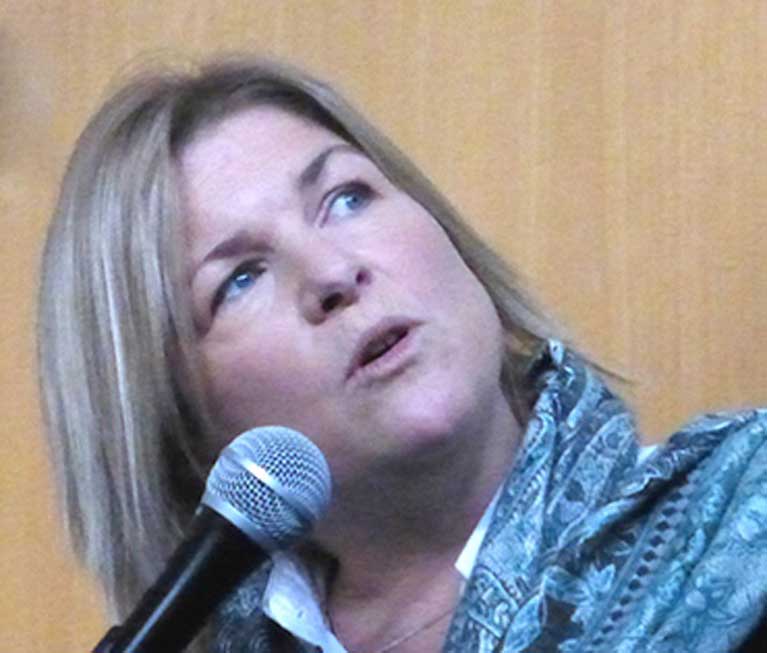 The professional face. Vera Quinlan of the Marine Institute speaking at an Irish Sailing Cruising Conference. Photo: W M Nixon
The professional face. Vera Quinlan of the Marine Institute speaking at an Irish Sailing Cruising Conference. Photo: W M Nixon
But with her partner Peter Owens she is also a leading member of the west coast cruising community, and her father is Fergus Quinlan, who in 2010-2013 with his wife Katherine completed a comprehensive three-year Global circumnavigation in the 12m van de Stadt steel cutter Pylades which he built himself, an exemplary cruise which was deservedly awarded the Irish Cruising Club’s premier award three years on the trot.
Very and Peter of Kinvara have been making their own way in the cruising scene for some time now with increasingly long ventures with the 43ft 1993-built Bruce Roberts Mauritius Class steel ketch Danu, and they’ve been implementing an up-grade programme to get their fine ship ready for a 14-month Atlantic circuit when their family of Lilian (now 9) and Ruari (9) had reached a stage where a 14-month break (with of course homeschooling on board) would not make it unduly challenging for them to re-join the school system in September 2020.
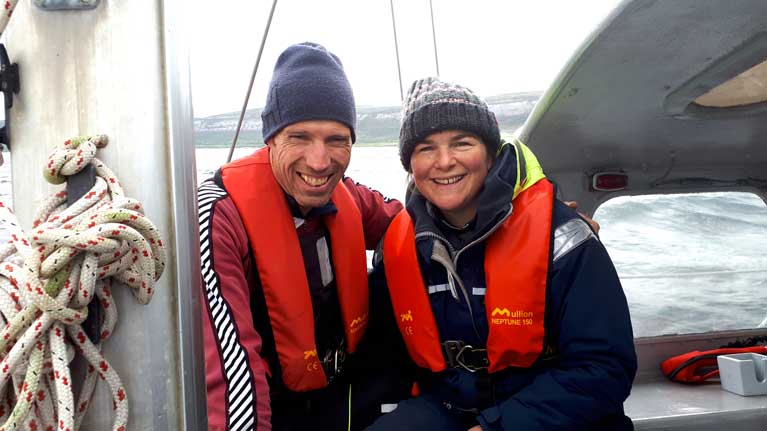 Peter Owens and Vera Quinlan departing from Kinvara in their ketch Danu
Peter Owens and Vera Quinlan departing from Kinvara in their ketch Danu
The voyage got under way at the end of last week when Galway Bay as every bit as cold as the rest of Ireland, but at least they’d fair winds to carry them south for an overnight passage to Dingle, where they found themselves over-lapping with the finish in the Volvo Dun Laoghaire Dingle Race, and allocated a handy berth in the town marina beside the classic 1939-built 50ft ketch Amokura (Paul Moxon) which had been racing in the two-handed division.
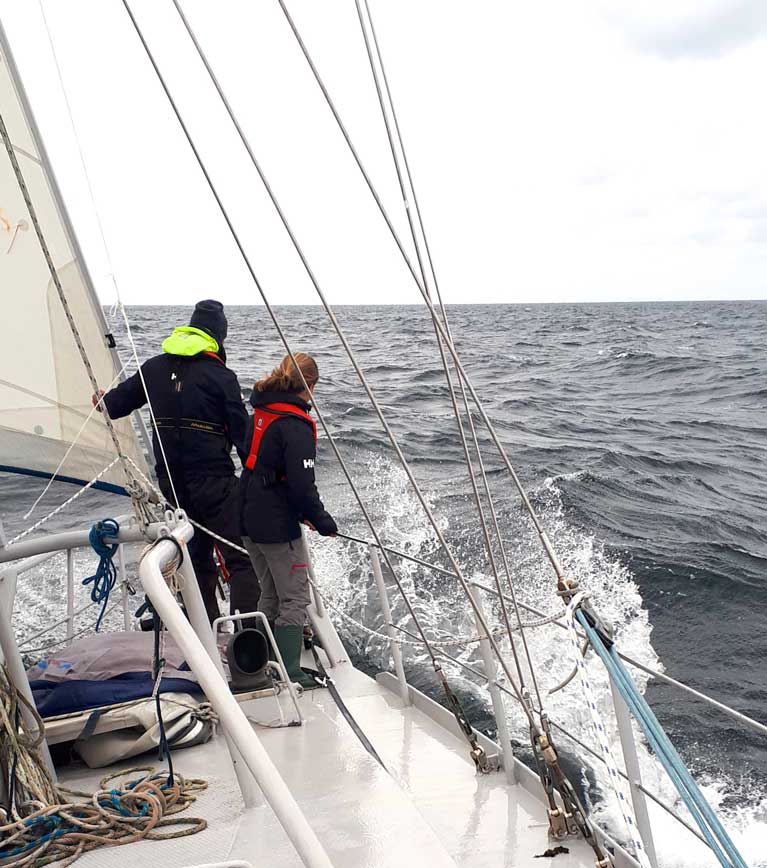 Away at last. It may have been cold in Galway Bay, but Danu’s family crew had a fair wind and dolphins to accompany them as they left their home waters for 14 months away. Photo: Vera Quinlan
Away at last. It may have been cold in Galway Bay, but Danu’s family crew had a fair wind and dolphins to accompany them as they left their home waters for 14 months away. Photo: Vera Quinlan
Amokura had struggled over the final miles to Dingle after sustaining damage to an upper spreader, but having completed the race and thereby fulfilled their qualifications for August’s Fastnet Race, as can-do folk themselves Peter and Vera were intrigued by how Paul and his shipmate Steve Jones set up a workshop on Amokura’s deck to make and install a new spreader, something which they did so efficiently that they still had the time to attend the legendary end-of-race party and prize-giving in the Dingle Skelligs Hotel where - as Paul reports - they got a great welcome from the other crews.
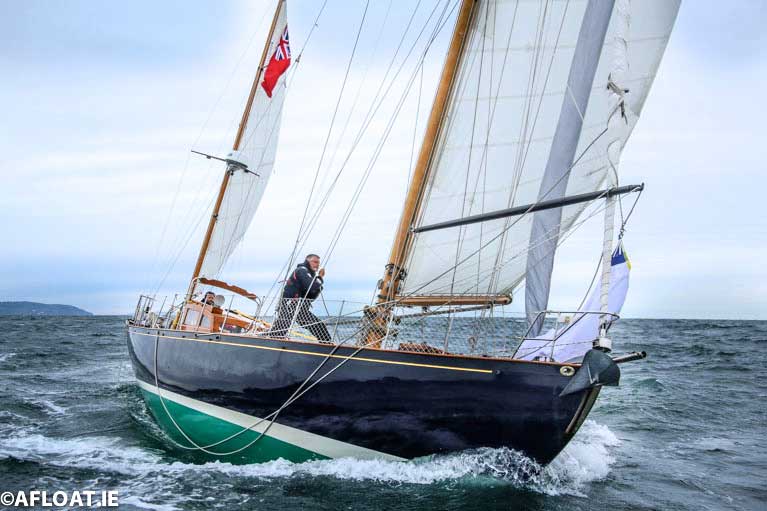 New neighbours met by Danu in Dingle. Paul Moxon’s classic 50ft 1939-built yawl Amokura at the start of the Dingle Race, in which she sailed in the two-handed division. Steve Jones is hoisting the spinnaker in the lumpy conditions which prevailed at the start. It went up without a hitch, but in Dingle they had to deal (successfully) with a broken spreader. Photo Afloat.ie/David O’Brien
New neighbours met by Danu in Dingle. Paul Moxon’s classic 50ft 1939-built yawl Amokura at the start of the Dingle Race, in which she sailed in the two-handed division. Steve Jones is hoisting the spinnaker in the lumpy conditions which prevailed at the start. It went up without a hitch, but in Dingle they had to deal (successfully) with a broken spreader. Photo Afloat.ie/David O’Brien
These two very different boats went their various ways, with Amokura back in her home port of Falmouth by Tuesday thanks to a useful slant from a sou’westerly, while the crew of Danu continued to settle into shipboard life and deal with the items which still remained on what had been a formidable “to do” list, and in time they found themselves in Baltimore and ready for the off.
The cruise will follow the familiar yet somehow always fresh course down the coasts of southwest Europe and on to the Canaries and Cape Verdes before making the Atlantic crossing to cruise the South American coast before making their way the length of the Caribbean islands and then starting the passage home via Bermuda and the Azores.
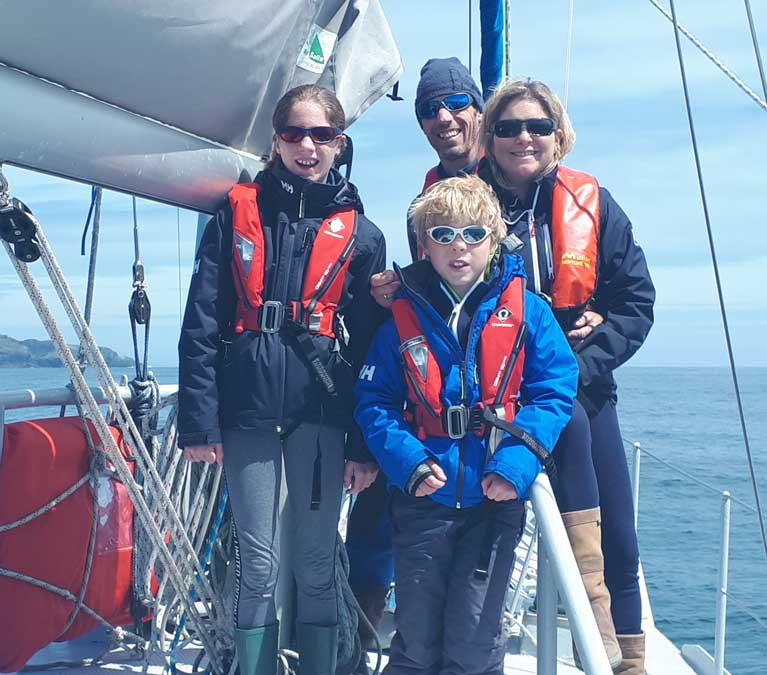 This is what we came for….Danu’s crew finally find warmer weather as they approach Mizen Head this week – they are Lilian (left, aged 11) Ruairi (foreground, aged 9), Peter behind, and Vera on right. Photo: Vera Quinlan
This is what we came for….Danu’s crew finally find warmer weather as they approach Mizen Head this week – they are Lilian (left, aged 11) Ruairi (foreground, aged 9), Peter behind, and Vera on right. Photo: Vera Quinlan
With their background specialised in the ways of the sea, Vera and Peter and their family will inevitably be getting much more from this venture than many other sailors, and we look forward to hearing how it all progresses as the months go by. But for now, the contrast between the civilised pace of the voyage of the Danu and the way Irish sailing has been going through a frenetic racing phase in recent weeks could not be greater,
Time was when the gentle peak of the sailing season was set in July in the north and early to mid-August in the south. But anyone who has been following the coverage on Afloat.ie for the past couple of months will assume that the racing programme takes off with full rocket assistance in April, and shows every sign of zooming along until October and beyond.
So here we are with the NYC’s record-breaking (in every way) Volvo Dun Laoghaire to Dingle Race already put away with Paul O’Higgins’ Rockabill VI (RIYC) the winner and the date for the next one set for good measure (it’s 9th June 2021), before that we had the ICRA Nats in Dun Laoghaire with Caroline Gore-Grimes skippering the ever-competitive X302 Dux (HYC) to overall victory, ahead of that the Lambay Race in Howth saw the vintage Club Shamrock Demelza (Windsor& Steffi, HYC) take the overall prize), in late May the Scottish Series in Loch Fyne saw Andrew Craig’s J/109 Chimaera (RIYC) the Champion of Champions), and in a week’s time we’ll be in the throes of the Sovereigns Cup in Kinsale, with 90 boats plus shaping up for a perfect series. Read Afloat's Cup preview here.
Then there comes the big one, the Volvo Dun Laoghaire Regatta from July 11th to 14th. With entries still open until the end of June, 456 boats have already signed up in 24 classes with three of those classes topping more than the twenty entries apiece. And Dublin Bay sailors being what they are, if the weather starts to shape up properly we can be sure there’ll be late entries banging at the door to push towards the 500 mark.
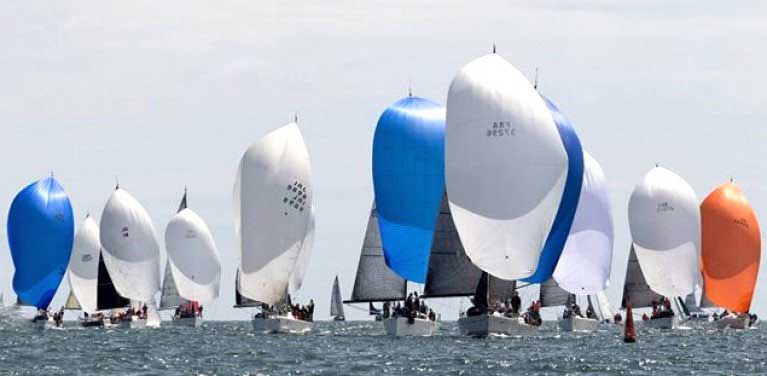 High summer for the Volvo Dun Laoghaire Regatta. Entries are already at 456 boats for July 2019’s event in 24 classes of which three have ore than 20 entries apiece. Photo Fotosail/Gareth Craig
High summer for the Volvo Dun Laoghaire Regatta. Entries are already at 456 boats for July 2019’s event in 24 classes of which three have ore than 20 entries apiece. Photo Fotosail/Gareth Craig
East Coast sailors tend to assume that things slow down markedly after that, but that’s only the usual metropolitan bias which also overlooks the fact that ISORA racing has resumed. But basically, the reality is the emphasis moves back west. The pace-setting Foynes Yacht Club is hosting the 2109 WIORA Championship from 24th to 27th July, while traditionalists are already gearing themselves up for the 40th Anniversary Cruinnui na mBad Festival in Kinvara from August 9th to 11th, even if dyed-in-the-wool Galway Hooker Sailors will assure you that the purest essence of their sailing is found at the annual MacDara’s Day racing on July 16th at Macdara’s island out beyond Roundstone in Connemara.
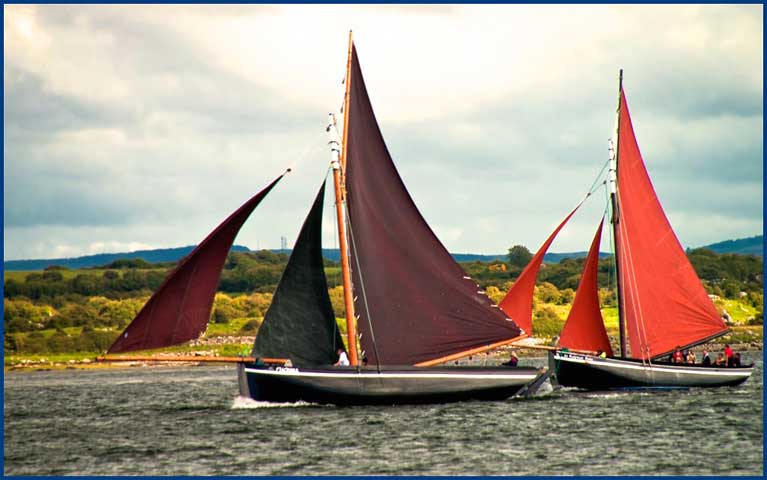 Kinvara’s renowned Cruinnui na mBad from August 9th to 11th will be celebrating its 40th Anniversary
Kinvara’s renowned Cruinnui na mBad from August 9th to 11th will be celebrating its 40th Anniversary
Meanwhile, although West Cork came to life with the Baltimore Wooden Boat Festival late in May, it’s August when the waters inside the Fastnet Rock really come to life, and fanatical racing types find that for once it is possible to do both GAS Calves Week at Schull from 6th to 9th August, and then Cowes Week from 10th to 17th August.
This may sound too much of a good thing to many of us, but for boat racing mega-fans like Mark Mansfield, it makes for a very attractive proposition - he reckons that the two events provide the most perfect and stimulating contrasts.
But for many topline Irish offshore sailors, August is going to be a tricky one, as the re-jigging of the Rolex Fastnet Race start back to Saturday, August 3rd has created an imbalance in the usual August setup. In a more leisurely age, setting off to race round the Fastnet seemed the natural way to round out Cowes Week, where you might have sailed a race or three.
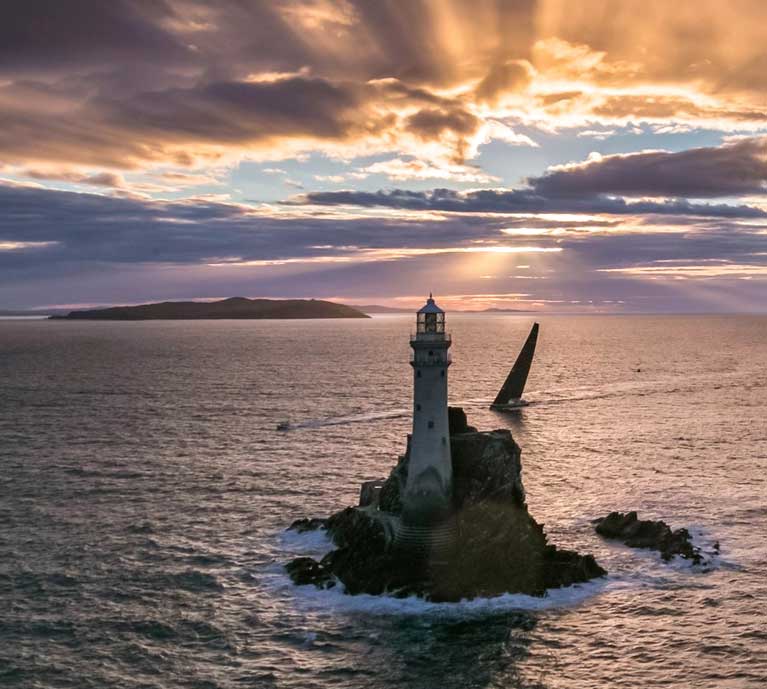 The ultimate turning point. More than 350 boats will be racing round the Fastnet Rock early in the second week of August in the biennial Rolex Fastnet race, including a record turnout of more than 20 IMOCA 60s. Photo: Rolex
The ultimate turning point. More than 350 boats will be racing round the Fastnet Rock early in the second week of August in the biennial Rolex Fastnet race, including a record turnout of more than 20 IMOCA 60s. Photo: Rolex
But in 2019 – the 40th Anniversary of the Fastnet Disaster of 1979 – the fact that the race star time was arbitrarily moved back to early August to avoid the usual late-season weather deterioration means that if you want to savour the Cowes Week experience, you somehow have to summon up the energy and enthusiasm post-Fastnet, which for Irish boats also means heading further east again from the Fastnet finish at Plymouth before finally sailing west for home from Cowes in late August.
All this must be totally yawnsvillle for the many who find all their racing and sailing needs in Ireland and nearby waters, and even more off the scale of interest for those who see cruising as the ultimate in sailing. So for this weekend at least, the contemplation of the cruise of the Danu, and other fascinating voyages like it, is quite rightly top of the agenda.
Lorient in Brittany was the first city to sign up as a twin to the proud citizens of Galway as far back as 1975. It was a statement of friendship and a commitment to exchange cultural experiences between the people of both historic ports of the Atlantic coast, and it has lasted the test of the last five decades.
Both cities have long and proud maritime histories. They also have very strong cultural ties as they share vibrant Celtic roots, and Celtic culture continues to be very evident in both cites through the everyday use of Gaeilge, Breton, traditional music, dance and the arts.
Co-incidentally, both cities are also the western outposts of their respective countries, surrounded by natural beauty. They have been fishing ports for centuries. They are both aware of the bounties and the threats imposed by the wild Atlantic. This shared life experience made for a good twinning. Obviously sailing - from traditional vessels to modern yachts - is a passion cherished by both.
"The West of Ireland sailing community, from Westport to Kilrush grabbed the idea with both hands"
Sailing fleets from both cities joined forces for a number of very successful events during the ’70s and ’80s, but with other distractions nearer home, the tradition subsequently died away. These sailing adventures started with the northbound departure of a fleet of yachts from Lorient Harbour. After crossing the Celtic Sea and passing by the south-west coast of Ireland, the French fleet arrived into Galway for some serious partying. In Galway, the French boats were joined a Galway fleet to form a formidable flotilla for the southbound journey to Lorient. There, the mother of all parties ensued.
Enda O'Coineen was the catalyst to motivate JeanGab Samzun from Lorient and Cormac Mac Donncha from Galway Bay Sailing Club (GBSC) to join forces last summer in an effort to revive the event in 2019. The West of Ireland sailing community, from Westport to Kilrush grabbed the idea with both hands.
Both City Councils have rowed in behind the idea. Mayor of Galway, Niall McNellis, has been a big supporter. Events have been planned for the Harbour Hotel on the eve of the departure from Galway docks on the 11th July and also at the docks marina on the day of departure, 12th July. For the 2019 event, the French team are again pulling out all the stops for their stage of the event, with plans to fly some Irish dancers in from Galway for the occasion.
 Lorient is the ultimate destination, but there’ll be many stops – including islands – on the way
Lorient is the ultimate destination, but there’ll be many stops – including islands – on the way
The two cities have signed up 33 skippers, mostly from the West of Ireland, to join the craic. There has been great support from neighbouring clubs in Mayo and Clare as well as boats from Lough Derg clubs. The Galway boats to register, from Rosamhil Marina, Galway City Sailing Club, Galway Docks Marina and GBSC, have already reached 17. There is a healthy fleet of 6 joining from Westport on Clew Bay, with four boats from Lorient while another six are joining from Kilrush, Lough Derg and Cork.
A number of well known West of Ireland sailors have signed up for the trip, including Westport’s Jarlath Cunnane of Northabout renown as well, as Dr Michael Brogan from Kinvarra. Michael plans to skipper the renowned extra-large Galway Hooker, MacDuach, to France for a Cruise-in-Company which will cover 1,100 miles in all.
On the Irish coast, the route from Galway towards Lorient will follow the shores of Munster as far as Kinsale, and the committee is very grateful for the warm welcome received from the folks at Kinsale Yacht Club, as well as the Harbour Master in the Isle of Scilly, and of course to the Lorient City Club for organising events on Ile De Groix and in Lorient Harbour.


